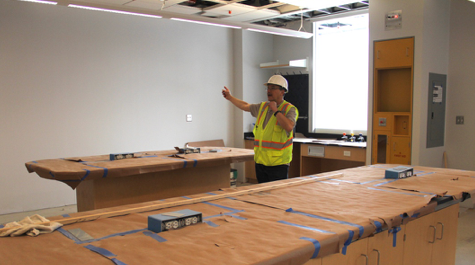A New Role in New Construction
Over the past several years, William & Mary has made great strides in improving its physical spaces to support academics. Two such projects are the construction of the third installment of the Integrated Science Center (ISC3) and the renovation of Tyler Hall. These have been in the works for some time now, and their existence may come as no surprise. However, what’s new is the role the Information Technology department has taken in these projects.
IT’s New Role
Prior to these two projects, the technology design in new/remodeled buildings had always been contracted out, but now that has changed. “In the past, the architect would hire an AV designer and integrator,” said John Drummond, academic technology engineering manager and project team member. “But this time around they are doing things a little differently. We now contract these people. This gives IT more leverage and a prominent role in coordinating the infrastructure with the classroom technology that will occupy it.”
“The College is trying a new approach to the integration of presentation and multi-media technology in new or renovated buildings,” adds David Shantz, a classroom support engineer and IT project team member. “We now work with College faculty and staff in concert with building architects, designers, and AV and construction consultants to develop what will become the final construction plan.”
IT’s previous role was limited to setting up data and phone lines, and resolving incompatibilities between equipment and technology once the classrooms were in use. Getting IT involved early means that we are able to implement equipment that is compatible with the technologies that professors use as well as provide support for the equipment when the buildings are fully operable.
A Partnership with Faculty
Drummond, Shantz, and the rest of the IT team work closely with faculty in an effort to equip classrooms effectively and efficiently. Doing the design in-house allows W&M IT to directly address the technology needs of the W&M faculty that will be occupying the new space. The team then works with the contractors to lay out the appropriate technology room by room.
“My focus is on the system building blocks and our AV integrators,” reports Shantz. “My goal is to make the technology transparent; intruding as little as possible. John [Drummond]’s focus is on the faculty and systems concepts.”
As mentioned, Drummond works with faculty members to understand their various instructional goals, and attempts to accommodate those goals with the best available technology. One such faculty member with whom Drummond closely works is Eric Bradley, the academic coordinator for the ISC project, as well as the chair of the Biology department at W&M.
“This is an IT-essential building,” notes Bradley. “A large amount of instruction in lecture halls, classrooms, PAC labs, teaching laboratories, and research labs is centered here, and it all depends on IT infrastructure and support.”
For faculty members such as Bradley, being able to interface with IT and other building contractors is a crucial aspect of the process. Typically, professors could only hope to have the necessary tech in their classrooms. Now, they are able to conduct an open dialogue and take an active role in the construction of their teaching spaces.
The project has not been an easy one according to Drummond. As faculty needs have unfolded, plans for specific technology infrastructures have been scrapped for fresh ones. “It is tough to coordinate with such a large number of stakeholders,” says Drummond. “But I think we will get it right in the end.”
A New Home for HPC
Beyond the classroom installations, W&M IT is also moving part of our department to the newly constructed building. W&M IT’s High Performance Computing (HPC) team supports data-intensive research computing at W&M. The 3-person HPC team, along with their impressive array of high-tech equipment, will be moving to the new Integrated Science Center 3 (ISC 3) in July of 2016.
The move will bring together the SciClone cluster (currently in Jones Hall) and Storm cluster (currently in the ARC at the Jefferson Lab) into one integrated unit. The SciClone cluster has been the main staple of HPC computing on campus. It provides about 1200 computing cores and over 120 TB of storage. Storm is a recent addition to the fleet, coming on board in 2014.
During the move, equipment such as switches, nodes, fileservers, and front-ends will have to be un-cabled and un-racked, transported to the new building. Then they will be re-cabled and re-racked in a different layout, and with a different network configuration. Because this is such a large undertaking, there will be some downtime for each of the systems. Announcements will be forthcoming.
Once the move is complete you can stop by ISC3 and see the HPC equipment yourself. The glass wall of the HPC server room allows you to watch the exciting computing power in action. HPC will be located on the 1st floor, room 1251.
 Skip to main content
Skip to main content

